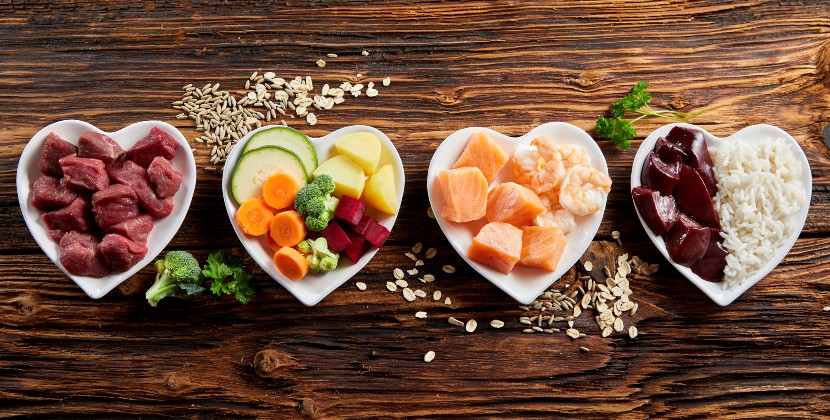
DogFoodAdvisor is reader supported See how
Dog Food Advisor is 100% impartial and is never paid to promote any brand. But if you buy using links on this page, we may earn a referral fee.
What makes dog food good? One of the most important aspects of being a pet parent is choosing the best food for your dog — obvious, right? And probably the reason you visit Dog Food Advisor or subscribe to our newsletter.
When we rate food, we look at the ingredients. Naturally, you want high-quality ingredients that provide your dog with a nutritious diet. But what is a ‘good ingredient’?
We spoke to the experts at 5-star-rated Open Farm to find out. Open Farm produces a range of pet foods, including freeze-dried raw, dry, gently-cooked fresh, and a more price-accessible oven-baked GoodBowl. Open Farm places great emphasis on transparency and ethical sourcing, so they know a thing or two about good dog food ingredients.
They came up with three key areas.
Knowing where your food comes from
Understanding where your dog’s food is made and what exactly they are eating is essential for a pet parent.
While you might think choosing a dog food that meets the AAFCO standards and is labeled according to the FDA guidelines is enough to ensure high-quality ingredients, it’s also recommended that you do some extra research on the brand.
“When a pet parent is able to trace back the ingredients in the recipe (not only the origin but also the nutritional benefit), it makes them feel really confident about what exactly they’re feeding their dog,” says Paige Arsenault, Impact Specialist.
Vetting a company’s standards against their claims, including their commitment to ingredient traceability and safety, is crucial. Brands such as Open Farm that actively trace ingredients can promptly address any health or safety concerns that may arise, often through audited farms verified by third-party organizations.
High-quality proteins
High-quality dog foods will have a protein listed as the first ingredient, particularly if you feed them a wet food.
Meat meals, such as chicken or beef, can be included in the ingredients, but they should not be the primary ingredient. These proteins are of a lower quality but still contain vital nutrients for your dog and while this makes them a great addition to dog food, you don’t want your pet to miss out on the higher-quality meats too.
The most common protein sources in dog food include meat, poultry, fish, and eggs. Certain plant-based ingredients such as whole grains, legumes, and beans can provide significant amounts of protein too but most likely to be a meat or fish source.
Where does high-quality quality protein come from?
Much like choosing your own chicken or beef, have a look at where the protein in your dog’s food came from. A high-quality meat protein source will mean the animals were:
- Raised ethically and humanely
- Grass-fed
- Pasture-raised
- Had space to roam
- Fed a nutritious diet
- Had the ability to express natural behaviors
Similar conditions will apply if you are opting for a fish protein. A high-quality fish will be:
- Wild-caught and sustainably sourced
- Fed a natural diet
- Fishing methods that reduce bycatch, and seafloor damage, and promote biodiversity
By choosing a dog food that is 100% Animal Welfare certified means the animals have been raised in the best possible conditions with a high-quality life. Therefore, your dog will consume a good quality product with more nutrition. The same applies to plant-based proteins as they will have been sustainability-grown and ethically sourced.
“The inextricable link between the way ingredients are grown and raised and the nutrition they deliver is what makes animal welfare extremely important,” says Megan Tuttle, Director of Impact. “It’s why we partner with humane and regenerative farms and ranches that uphold the highest standards.”
Wholesome nutrition
Beyond the protein source, we know that dogs are omnivores so their diet extends beyond meat. When looking at the complete ingredient list, you will find that quality dog foods steer clear of growth hormones and antibiotics.
“Check your labels, being mindful of ingredients that lack purpose,” says Irene Gunawan, Director of R&D. Corn and soy, for instance, are unlikely to contribute meaningfully to your pet’s nutritional needs.”
Instead, opt for products crafted to support pets’ overall health and vitality, backed by veterinary expertise. Look for non-GMO fruits and vegetables, along with superfoods like turmeric and coconut oil which will enrich your dog’s diet with essential nutrients. Wholesome grains such as oats and quinoa will provide additional nutritional benefits, and a blend of essential vitamins and minerals will additionally contribute to a well-rounded diet.
Final word
The Dog Food Advisor does not accept money, gifts, samples or other incentives in exchange for special consideration in preparing our reviews.
However, we do receive a referral fee from online retailers (like Chewy or Amazon) and from sellers of perishable pet food when readers click over to their websites from ours. This helps cover the cost of operation of our free blog. Thanks for your support.
For more information, please visit our Disclaimer and Disclosure page.
Article reviewed by
Andrew Dickens
Editor
Andrew Dickens is an award-winning writer, editor and broadcaster with 20 years in journalism. He’s created compelling content on film and television, travel, food and drink, physical and mental health, business, sport, technology and politics. And, of course, dog food.




